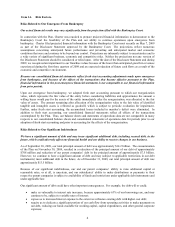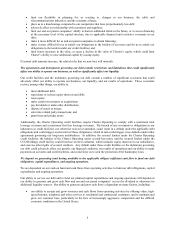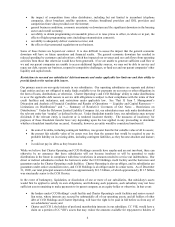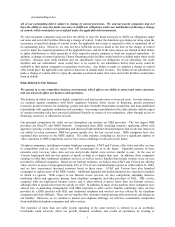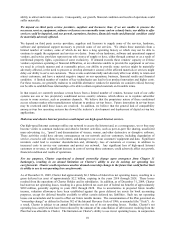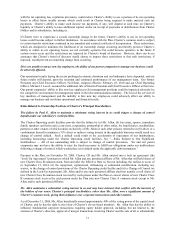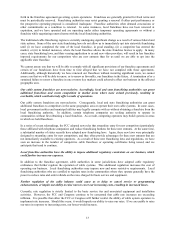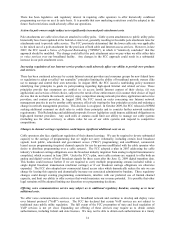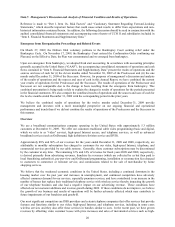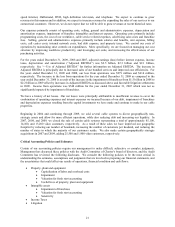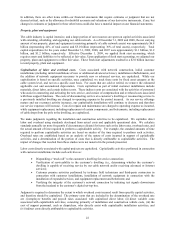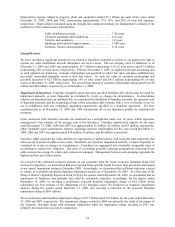Charter 2009 Annual Report Download - page 17
Download and view the complete annual report
Please find page 17 of the 2009 Charter annual report below. You can navigate through the pages in the report by either clicking on the pages listed below, or by using the keyword search tool below to find specific information within the annual report.14
There has been legislative and regulatory interest in requiring cable operators to offer historically combined
programming services on an á la carte basis. It is possible that new marketing restrictions could be adopted in the
future. Such restrictions could adversely affect our operations.
Actions by pole owners might subject us to significantly increased pole attachment costs.
Pole attachments are cable wires that are attached to utility poles. Cable system attachments to public utility poles
historically have been regulated at the federal or state level, generally resulting in favorable pole attachment rates for
attachments used to provide cable service. The FCC previously determined that the lower cable rate was applicable
to the mixed use of a pole attachment for the provision of both cable and Internet access services. However, in late
2007, the FCC issued a Notice of Proposed Rulemaking (“NPRM”), in which it “tentatively concludes” that this
approach should be modified. The change could affect the pole attachment rates we pay when we offer either data
or voice services over our broadband facility. Any changes in the FCC approach could result in a substantial
increase in our pole attachment costs.
Increasing regulation of our Internet service product could adversely affect our ability to provide new products
and services.
There has been continued advocacy by certain Internet content providers and consumer groups for new federal laws
or regulations to adopt so-called “net neutrality” principles limiting the ability of broadband network owners (like
us) to manage and control their own networks. In August 2005, the FCC issued a nonbinding policy statement
identifying four principles to guide its policymaking regarding high-speed Internet and related services. These
principles provide that consumers are entitled to: (i) access lawful Internet content of their choice; (ii) run
applications and services of their choice, subject to the needs of law enforcement; (iii) connect their choice of legal
devices that do not harm the network; and (iv) enjoy competition among network providers, application and service
providers, and content providers. In August 2008, the FCC issued an order concerning one Internet network
management practice in use by another cable operator, effectively treating the four principles as rules and ordering a
change in network management practices. This decision is on appeal. In October 2009, the FCC released a NPRM
seeking additional comment on draft rules to codify these principles and to consider further network neutrality
requirements. This Rulemaking and additional proposals for new legislation could impose additional obligations on
high-speed Internet providers. Any such rules or statutes could limit our ability to manage our cable systems
(including use for other services), to obtain value for use of our cable systems and respond to competitive
competitions.
Changes in channel carriage regulations could impose significant additional costs on us.
Cable operators also face significant regulation of their channel carriage. We can be required to devote substantial
capacity to the carriage of programming that we might not carry voluntarily, including certain local broadcast
signals; local public, educational and government access (“PEG”) programming; and unaffiliated, commercial
leased access programming (required channel capacity for use by persons unaffiliated with the cable operator who
desire to distribute programming over a cable system). The FCC adopted a plan in 2007 addressing the cable
industry’ s broadcast carriage obligations once the broadcast industry migration from analog to digital transmission is
completed, which occurred in June 2009. Under the FCC’ s plan, most cable systems are required to offer both an
analog and digital version of local broadcast signals for three years after the June 12, 2009 digital transition date.
This burden could increase further if we are required to carry multiple programming streams included within a
single digital broadcast transmission (multicast carriage) or if our broadcast carriage obligations are otherwise
expanded. The FCC also adopted new commercial leased access rules which dramatically reduce the rate we can
charge for leasing this capacity and dramatically increase our associated administrative burdens. These regulatory
changes could disrupt existing programming commitments, interfere with our preferred use of limited channel
capacity, and limit our ability to offer services that would maximize our revenue potential. It is possible that other
legal restraints will be adopted limiting our discretion over programming decisions.
Offering voice communications service may subject us to additional regulatory burdens, causing us to incur
additional costs.
We offer voice communications services over our broadband network and continue to develop and deploy voice
over Internet protocol (“VoIP”) services. The FCC has declared that certain VoIP services are not subject to
traditional state public utility regulation. The full extent of the FCC preemption of state and local regulation of
VoIP services is not yet clear. Expanding our offering of these services may require us to obtain certain
authorizations, including federal and state licenses. We may not be able to obtain such authorizations in a timely


